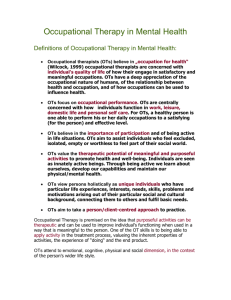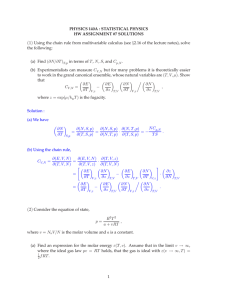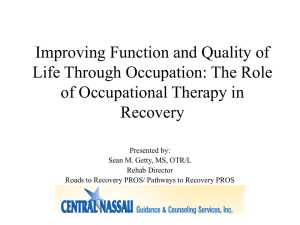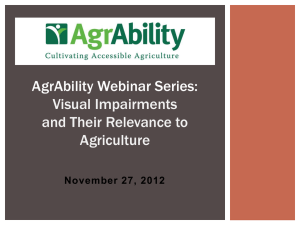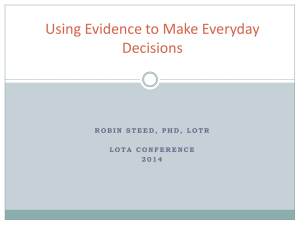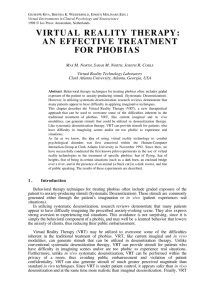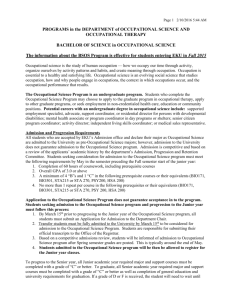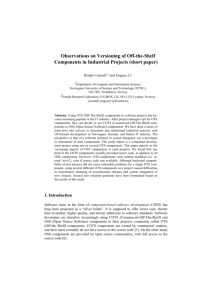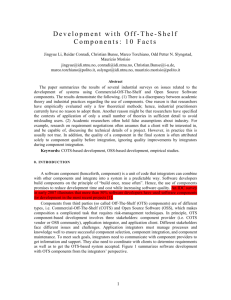handout 2 - Association for Education and Rehabilitation of the Blind
advertisement
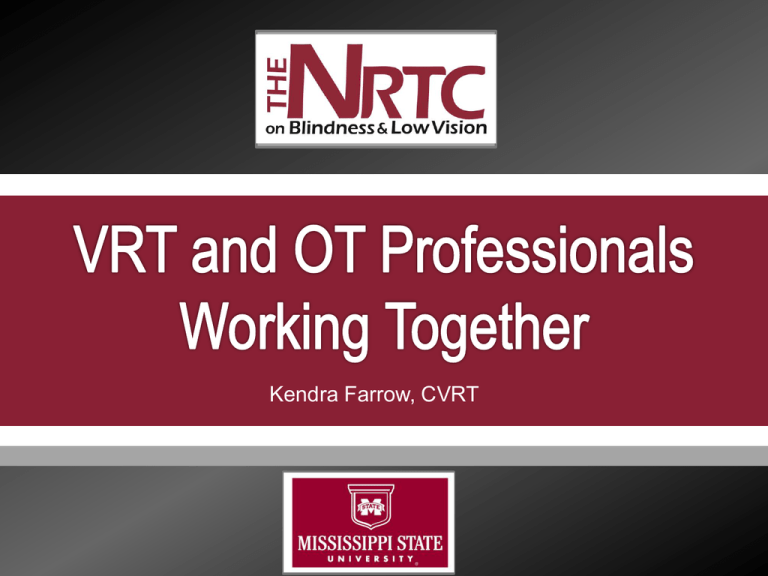
Kendra Farrow, CVRT VRTs address the physical, emotional, and social implications of vision loss Provides counseling and training in NEW skills and adaptive techniques Success is based on level of independence and emotional adjustment Work to enhance vocational opportunities, independent living, and educational development OTs address physical, cognitive, psychosocial and sensory performance Provides activities with an aim towards improving health, well-being, and quality of life Success is based on increasing participation and performance Engagement in daily life activities (occupations) that support health and participation in home, school, the workplace, and community life (AOTA, 2008) OT Work with all impairments as well as states of wellness If billing insurance, Treatment is defined in the Plan of Care (POC) written by the OT & authorized by the physician • OT must perform an evaluation to identify medical necessity of services • Anyone can refer. • If utilizing medical insurance requires physician involvement VRT Focuses on blindness and vision impairment Has community B/VI connections Free services, generally Flexibility in service hours Anyone can refer 1. OTs with training to work with Low Vision and may also work in the Blindness Stream. • Services are directed at LV patients 2. OTs who work in other settings and may occasionally have a patient who is also experiencing vision loss. • OTs in hospitals and nursing homes without LV training frequently provide vision services to clients with field limitations and loss secondary to brain injury If we don’t use the same words with the same meanings, it leads to; misunderstandings, confusion, and frustration. If we can’t communicate, we can’t work together. Disability and Health (ICF) Developed by the World Health Organization to help communication Offers specific terminology and definitions to describe disability and functioning OTs use this language OT Patient SNF (skilled nursing facility) MCB Physician Prescription or Orders Plan of Care (POC) Training, Participation Eccentric Viewing Training (EVT) Using Preferred retinal locus (PRL) VRT Client Nursing Home Medicare part B Referral Individualized service plan Teaching Eccentric viewing Vision – OT uses this phrase to describe vision rehabilitation, including legal blindness. Low Vision – VRT uses this phrase to describe specific training Low Terms Blindism Acuity Photophobic Charles Bonnet Syndrome Lumens Diopter Concepts Perceived brightness Color perception Contrast sensitivity Focal distance Color temperature Principles of task lighting Reading an eye report Measuring low vision using near and distance charts Knowledge of low vision aids and appliances Braille instruction Transition services Advocacy skills Concept development Training under blindfold Adjustment to vision loss counseling Link to vocational services Sighted guide and protective technique OT referrals must have: • Visual acuity of 20/70 or worse • Must have doctors’ orders and use medical codes, CPT and ICD9 VRT referrals are for clients who: • Want to learn Braille • Are not eligible for OT services • Need only one appointment http://www.mdsupport.org/deliverymodel/deliverymodel.html Model developed 2007 by a group of professionals representing: • Ophthalmology • Low Vision, optometry • Vision Rehabilitation • Occupational Therapy • The Consumer In 2002, Medicare issued transmittal AB-02-78: Medicare Coverage of Rehabilitation Services for Beneficiaries With Vision Impairment All licensed rehabilitative therapists eligible to provide and bill services provided to those with vision impairment • “Medicare beneficiaries who are blind or visually impaired are eligible for physician-prescribed rehabilitation services from approved health care professionals on the same basis as beneficiaries with other medical conditions that result in reduced physical functioning.” (Centers for Medicare & Medicaid Services, 2002) Diagnosing Physician Low Vision Evaluation Older Blind or Vocational Occupational Therapy VRT O&M Community Services Keep a positive attitude Respect the OT Offer training Offer shadowing opportunities Give resources Keep the door open for further communication Using a hand squeeze to detect tremors and strength Exercises for hand-eye coordination improvement Awareness of tripping hazards like throw rugs Occupational Therapists Over 100,000 OTs Vision Rehabilitation Therapists Approximately 600 CVRTs Up to 2,500 working in the field Overview of types of vision loss • Causes • Different patterns of vision loss • LV devices are not one size fits all What is a Low Vision Exam? • The importance of LV exam • LV doctors in your area • Stress the importance of using the correct device for each task Blindness Services • Your services and how to make a referral • Funding for LV devices • Courtesy rules for blindness • Other specialized services • NLS, Newsline • O&M services • Support groups Introduction to Functional vision impairment assessments & screens Consideration of co-morbidities Centralized OT domain articulating occupational roles, participation & performance Treatment, progress & discharge notes Introduction to functional and acuity assessment tools Implications of other disabling conditions Scope of work of the OT Documentation AFB eLearning The Carroll Center Lighthouse University of Alabama at Birmingham Hadley School The NRTC on Blindness and Low Vision Low Vision Rehabilitation: A Practical Guide for Occupational Therapists, Second Edition Occupational Therapy Interventions for Adults with Low Vision Be proud of what you do Keep up your certification Educate yourself about medical terminology Take opportunities to talk with OTs Provide education when appropriate Your role is valuable and needed VRTs can be a great resource Referring your patient to the VRT does not mean your services are unnecessary Keep learning, you can never learn everything about vision loss Communicate with your staff Have specific expectations and goals Support the VRT staff Require LV qualifications from OT staff Debrief and assess service delivery Communicate with staff Carmen Garcia-Hommel, OTL Occupational Therapist VisionCorps 244 N. Queen Street Lancaster, PA 17603 717.205.4145 717.291.9183 fax www.visioncorps.net Number of OTs http://www.bls.gov/ooh/healthcare/occupational-therapists.htm AOTA overview of LV Certification https://www.aota.org//media/Corporate/Files/EducationCareers/CE/SCLV%20Overv iew.pdf VRT Scope of Practice www.acvrep.org OT Scope of Practice www.aota.org International Classification of Functioning http://www.who.int/classifications/icf/en/ kfarrow@colled.msstate.edu 662-325-8694 The National Research and Training Center on Blindness and Low Vision at Mississippi State University www.blind.msstate.edu
